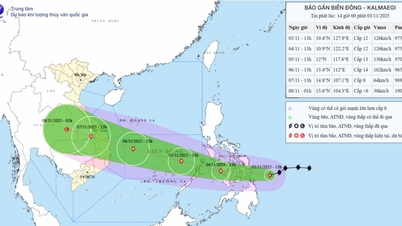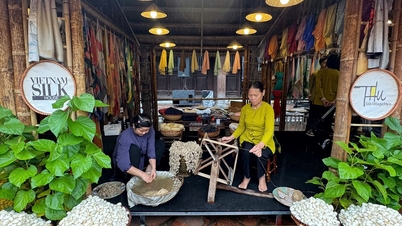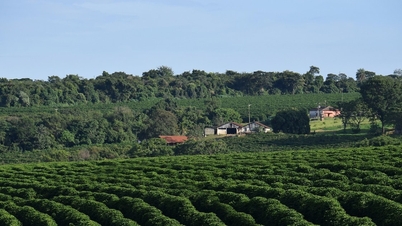ICO: Global coffee exports increase for second consecutive month
According to the International Coffee Organization (ICO), global coffee exports in March reached about 13 million bags (60 kg/bag), a slight increase of 0.6% compared to the same period last year. This is the second consecutive month of growth, after three consecutive months of decline.
However, in the first 6 months of the 2024-2025 crop year (from October 2024 to March 2025), global coffee exports still decreased by 1.9% over the same period, reaching only 67.9 million bags.
Green coffee beans alone reached 11.6 million bags in March, down 0.9% year-on-year. Cumulatively, exports of this coffee group have decreased by 3.2% since the beginning of the crop year to 60.6 million bags.
The main reason is a sharp decline in Robusta exports of 8.4% to 4.5 million bags, especially from Brazil, which fell by 83.6% to 0.14 million bags. This decline is mainly due to the adjustment after the period of unusually high exports from July 2023 to December 2024.
Brazilian Arabica coffee also declined slightly. In March, this group exported 3.5 million bags, down 2.4%, with Brazil alone down 9.4% to 2.8 million bags. This decrease is attributed to the high base of the previous year and the production cycle of the Arabica variety. 2023–2024 is considered a bumper crop, causing this year’s output to stagnate.
However, the decline from Brazil was offset by an impressive increase from Ethiopia, with 0.4 million bags exported in March, a 65.4% increase, as the country pushed to consume new crop supplies and clear inventories amid high global coffee prices.
Colombia also posted strong gains, reaching 1.3 million bags, up 25.3% year-on-year. This was the eighth consecutive month of growth for Colombian Arabica, which exported 1.2 million bags.
Other arabicas also saw a 5.9% increase to 2.3 million bags, with some countries including Costa Rica, Ethiopia and Honduras seeing increased exports, partially offsetting the declines from Mexico, Papua New Guinea and Peru.
In addition to green coffee, instant coffee exports in March increased sharply by 15.6% to 1.3 million bags. The share of instant coffee in total global coffee exports also increased to 9.9% in the first half of the 2024–2025 crop year, compared to 9% in the same period last year. Brazil continues to be the leading exporter of instant coffee with more than 0.3 million bags.
Roasted coffee also recorded an impressive increase in March, reaching 82,684 bags, up 27.3% year-on-year.

Coffee export prices increased in all regions except South America.
According to the International Coffee Organization (ICO), in March, most of the world's major coffee exporting regions recorded growth, except for South America. This caused South America's share of total global coffee exports to fall to 35.7%, the lowest level since June 2023.
In South America, coffee exports in March fell to 4.6 million bags, down 15.9% year-on-year. This was the region’s fourth consecutive month of decline after 14 months of growth. The main reason was Brazil, where exports fell sharply due to a year-on-year effect, when the country exported a record 49 million bags in 2023–24. At that time, Brazilian output surged to make up for a shortfall from Vietnam due to a poor crop. However, this year Vietnam had a good harvest, eliminating the need for replacement demand from Brazil, leading to a decline in exports from that country.
In contrast to South America, the Asia & Oceania region recorded a 6.1% increase in March, reaching 4.8 million bags. Indonesia contributed significantly to this result, more than doubling its exports to nearly 0.9 million bags. This surge was due to the low base of the previous year and the unique production cycle of coffee. In addition, high Robusta prices prompted countries to release inventories, contributing to the highest March export level in many years. However, Vietnam – the largest coffee exporter in the region – recorded a 4% decrease, reaching only 3.1 million bags, somewhat reducing the overall increase.
Africa continued to make significant progress, with exports in March reaching 1.6 million bags, a sharp increase of 36.3% compared to the same period last year. This was the 16th consecutive month of positive growth for the region. Ethiopia and Uganda were the two countries that contributed the most to this result, with increases of 65.8% and 72.9% respectively. A bumper crop, combined with high international coffee prices and an early selling trend, created favorable conditions for these two countries. Ivory Coast, on the other hand, recorded a sharp decline of 80.6% due to a smaller crop, exporting only 0.04 million bags.
The Central America and Mexico region also recorded a positive recovery, with March exports up 15.3% to over 1.9 million bags. The region has been on a cycle of 3–4 years of growth and 3–4 years of decline for many years. Excluding the COVID-19-affected 2019–20 crop year, the 2023–24 crop year would be the fourth consecutive year of decline. This raises the possibility that the 2024–25 crop year could mark the start of a new growth cycle.
Honduras and Mexico were the two countries that played an important role in this recovery, with increases of 12.7% and 33.6%, reaching 0.8 million bags and 0.3 million bags in March, respectively.
Source: https://baonghean.vn/ca-phe-xuat-khau-tang-gia-o-tat-ca-cac-khu-vuc-ngoai-tru-nam-my-10297341.html


![[Photo] General Secretary To Lam receives Singaporean Ambassador Jaya Ratnam](https://vphoto.vietnam.vn/thumb/1200x675/vietnam/resource/IMAGE/2025/11/03/1762171461424_a1-bnd-5309-9100-jpg.webp)
![[Photo] Lam Dong: Close-up of illegal lake with broken wall](https://vphoto.vietnam.vn/thumb/1200x675/vietnam/resource/IMAGE/2025/11/03/1762166057849_a5018a8dcbd5478b1ec4-jpg.webp)
![[Photo] Prime Minister Pham Minh Chinh receives the Chairman of the Japan-Vietnam Friendship Association in the Kansai region](https://vphoto.vietnam.vn/thumb/1200x675/vietnam/resource/IMAGE/2025/11/03/1762176259003_ndo_br_dsc-9224-jpg.webp)

![[Photo] Fall Fair 2025 and impressive records](https://vphoto.vietnam.vn/thumb/1200x675/vietnam/resource/IMAGE/2025/11/03/1762180761230_ndo_br_tk-hcmt-15-jpg.webp)
































































































Comment (0)